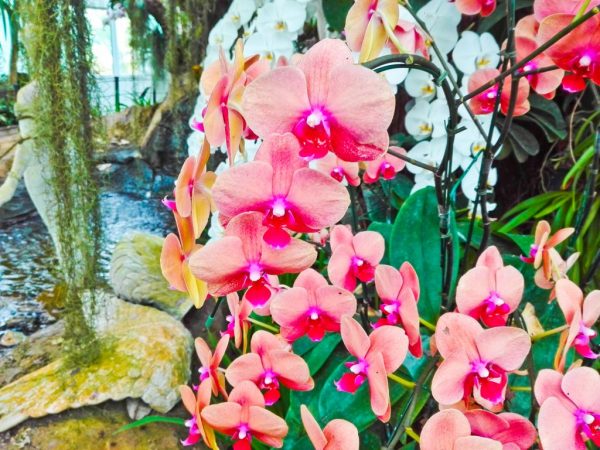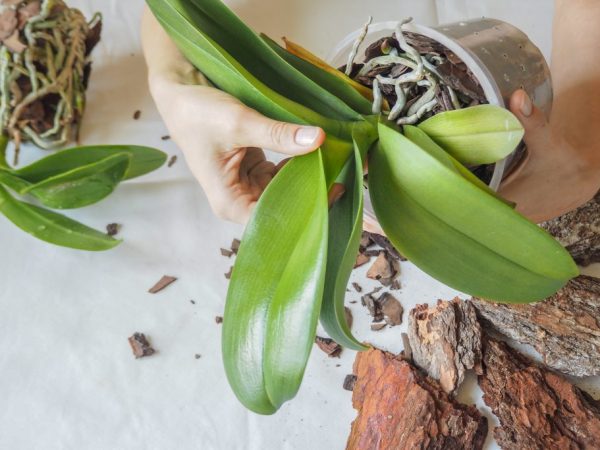Orchids without peduncles
Sometimes it is impossible to get the phalaenopsis orchid to release a peduncle, despite the fact that the plant looks healthy and receives the necessary care. Orchids without peduncles are the result of care errors.

Orchids without peduncles
How to make an orchid bloom
Homeland Phalaenopsis - hot and humid tropics, it reacts to drought and heavy rains. The first thing to do is to rearrange the plant in a radically different place from the previous one. For example, from a sunny windowsill to a darkened corner. You should also stop watering for a few weeks. Then return the phalaenopsis to its usual place and resume watering.
The second way is the temperature difference. Move the flower to a cool place so that the temperature drops by 10 ° C. Watering also decreases
The third way is exposure to chemical growth stimulants. With the preparations Epin, Stimulus or Success for a plant, it is possible to force an orchid to release a peduncle. Spray the flower every morning according to the instructions, and once a week soak the substrate in water with the addition of the drug. In such conditions, the orchid will be able to release a peduncle, and the arrow grows faster than usual.
Main problems
Plant age
If your home orchid does not produce a flower stalk, look at the number of shoots. Ideally, there should be 5-8 of them, but if there are fewer shoots, the flower is still young and flowering will weaken it.
The optimal age for blooming buds is 2-3 years.
If the age is suitable, and the plant does not release a peduncle, you can slightly accelerate the release of the arrow. Reduce the amount of nitrogen in fertilizers and apply a dry regime, temperature and lighting without changing.
How to achieve drought:
- reduce watering to 1 time per week;
- exclude spraying;
- remove top dressing;
- darken the lighting.
Under properly created drought conditions, the lower leaves will become soft, and the arrow will grow, wait for flowering soon.

If the home orchid does not produce a peduncle, look at the number of shoots
The orchid stopped blooming after transplanting
It is impossible to transplant a phalaenopsis flower at home without stress. The plant must re-adapt to a new substrate, get sick, it will take time. When the soil is changed, rooting takes place, all the forces are spent on this. By increasing the root mass, the plant will begin to develop aerial roots, leaves and an arrowhead. After a few months, new kidneys form.
Basic transplant rules:
- transparent pot with smooth walls and holes for drainage;
- use a special substrate with pieces of bark;
- the first watering is not done from above, but by lowering the pot into a large container with warm water;
- fertilizing the soil without nitrogen, every two weeks and before the plant releases the arrow;
- temperature difference no more than 5 ° С;
- protection from direct sunlight;
Compliance with these rules makes it possible to transplant at home with the least stress on the plant.
The orchid released a flower stalk and stopped
It takes several months from the beginning of the ejection of the arrow to the appearance of the buds, it all depends on the conditions created to make the orchid bloom.
Usually a decrease in temperature and humidity, a decrease in the amount of light affect the fact that there is a new peduncle, and the plant does not bloom. Find out the reason for such changes, if it is a change in weather conditions - provide optimal conditions on your own, for example, rearrange the plant on the southern windowsill. Start feeding and continue until the phalaenopsis blooms. After - stop, the overabundance is destructive, the plant withers or completely discards its color.
Peduncle pruning
If the orchid develops normally and blooms well, a dormant bud appears in each peduncle, or several, then so that after flowering the peduncle does not dry out, it should be properly cut off. It is recommended to cut off the arrow in the region of the third bud, if cut close to the roots - flowering will be belated, if cut higher - the new peduncle will go to the side, and the flower will fall over. Also, it is advisable not to wait until all the flowers fall off, and cut the arrow off earlier, this will significantly save the plant's strength. The yellowed peduncles are cut at the root.

It is recommended to cut off the arrow in the region of the third kidney
Reasons for the lack of flowering
Phalaenopsis are capricious plants, and do not tolerate temperature inconsistencies or their changes. Carefully choose the habitat of the phalaenopsis, this will ensure lush flowering and good health. If the grown variety is light-requiring, it makes sense to purchase a fluorescent lamp to provide optimal light.
Watering
Start from the general humidity in the room. If the room is dry, the plant will give most of the moisture through the leaves, and the substrate needs to be moistened more often. Florists usually choose the tactics of watering - drying-watering, assessing the state of the soil. Cover the soil with moss on top, and moisture will linger longer, give the flower a regular warm shower or dip the pot in a container of water for half an hour once a week.
Lighting
Orchids are light-loving plants, but protection from direct sunlight is important for them. An oriental or southern sill with shade is great for growing almost all phalaenopsis species. The optimal amount of light will ensure long and abundant flowering.
Fertilizers
It is optimal to use special fertilizers, without an excess of phosphorus-potassium substances, since they provoke the growth of foliage, but without ejection of buds. Choose a special fertilizer for orchids.
Optimal flowering conditions
In order not to have problems with flowering, adhere to the basic rules:
- develop a watering regime, taking into account the drying of the substrate;
- optimize lighting, you need to install an additional fluorescent lamp;
- create an optimal temperature regime, without sudden changes;
- fertilize the plant in a timely manner with special preparations;
- study the habitat of the cultivar.
Conclusion
The orchid is demanding, capricious and whimsical, its beautiful and long flowering is the result of daily work. Most often, flowering problems arise from inappropriate conditions. Provide her with home comfort, and the tropical beauty will surely delight her with her flowering. Pay attention to temperature and humidity as well as fertilizer quality and most problems can be avoided.


